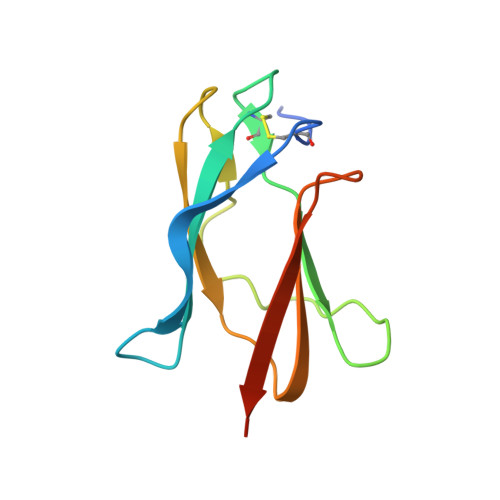Computational prediction and experimental characterization of a "size switch type repacking" during the evolution of dengue envelope protein domain III (ED3).
Elahi, M., Islam, M.M., Noguchi, K., Yohda, M., Toh, H., Kuroda, Y.(2014) Biochim Biophys Acta 1844: 585-592
- PubMed: 24373879
- DOI: https://doi.org/10.1016/j.bbapap.2013.12.013
- Primary Citation of Related Structures:
3WE1 - PubMed Abstract:
Dengue viruses (DEN) are classified into four serotypes (DEN1-DEN4) exhibiting high sequence and structural similarities, and infections by multiple serotypes can lead to the deadly dengue hemorrhagic fever. Here, we aim at characterizing the thermodynamic stability of DEN envelope protein domain III (ED3) during its evolution, and we report a structural analysis of DEN4wt ED3 combined with a systematic mutational analysis of residues 310 and 387. Molecular modeling based on our DEN3 and DEN4 ED3 structures indicated that the side-chains of residues 310/387, which are Val(310)/Ile(387) and Met(310)/Leu(387) in DEN3wt and DEN4wt, respectively, could be structurally compensated, and that a "size switch type repacking" might have occurred at these sites during the evolution of DEN into its four serotypes. This was experimentally confirmed by a 10°C and 5°C decrease in the thermal stability of, respectively, DEN3 ED3 variants with Met(310)/Ile(387) and Val(310)/Leu(387), whereas the variant with Met(310)/Leu(387), which contains a double mutation, had the same stability as the wild type DEN3. Namely, the Met310Val mutation should have preceded the Leu387Ile mutation in order to maintain the tight internal packing of ED3 and thus its thermodynamic stability. This view was confirmed by a phylogenetic reconstruction indicating that a common DEN ancestor would have Met(310)/Leu(387), and the intermediate node protein, Val(310)/Leu(387), which then mutated to the Val(310)/Ile(387) pair found in the present DEN3. The hypothesis was further confirmed by the observation that all of the present DEN viruses exhibit only stabilizing amino acid pairs at the 310/387 sites.
Organizational Affiliation:
Department of Biotechnology and Life Science, Graduate School of Engineering, Tokyo University of Agriculture & Technology, Nakamachi, Koganei-shi, Tokyo 184-8588, Japan.














